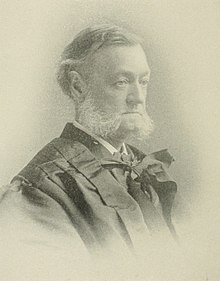George Shiras junior
George Shiras, Jr. (born January 26, 1832 in Pittsburgh , Pennsylvania , † August 2, 1924 ibid) was an American lawyer who was among other things a judge at the US Supreme Court.
Life
Shiras, the son of a brewery owner and businessman from Scotland , studied at Yale University after attending school and graduated with a Bachelor of Arts (BA) degree in 1853 . After a subsequent postgraduate study of law at the Law School of Yale University, he was admitted to the bar in the state of Pennsylvania in 1855 and then practiced as a lawyer in Dubuque and Pittsburgh for almost forty years .
After the death of Joseph P. Bradley on January 22, 1892, he was appointed associate judge of the US Supreme Court by US President Benjamin Harrison and held this office for more than ten years until his resignation on February 23, 1903. He was succeeded by the former US Secretary of State and previous judge at the US Court of Appeals William R. Day .
During his membership in the US Supreme Court, he wrote the reasons for the verdicts on 253 majority decisions and 14 dissenting opinions. He participated in the following major decisions:
- In the Pollock v. Farmers' Loan & Trust Co. (1895) had the Supreme Court on the by the Wilson-Gorman Tariff Act introduced the Income Tax Act of 1894 ( Income Tax Act of 1894 to decide). The court ruled that the income taxes introduced by this law on interest, dividends, and rent are direct taxes and that the law violates the United States Constitution because the state must be levied in proportion to the population.
- In the Plessy v. Ferguson (1896), the Court had to decide whether an Act of Louisiana , the separate compartments for citizens of white and black color in trains dictated against the breach US Constitution. In a judgment written by Brown, it denied this with 7 to 1 judges' votes and thus declared the provision of separate facilities for whites and blacks to be permissible under certain conditions. Through this judgment, the principle of separate but equal was de facto established as the basis of racial segregation in the southern states . John Marshall Harlan held a minor opinion against this fundamental decision . The decision of Plessy v. Ferguson was not recognized until 1954 through the judgment in the Brown v. Board of Education repealed.
After his death he was buried in the Allegheny Cemetery in Pittsburgh. His son, George Shiras III, was both a Republican member of the US House of Representatives for Pennsylvania and a respected photographer , most notably through his two-volume work Hunting Wild Life with Camera and Flashlight: a Record of Sixty Five years' Visits to the Woods and Waters of North America , which contained 960 nature photographs.
Background literature
- Justice George Shiras, Jr., of Pittsburgh, Associate Justice of the United States Supreme Court, 1892-1903 , 1953
Web links
- Biography (Supreme Court Media)
- George Shira's junior in the nndb (English)
- George Shira's junior in the database of Find a Grave (English)
- openlibrary.org
Individual evidence
- ↑ "No capitation, or other direct, Tax shall be laid, unless in Proportion to the Census or Enumeration in before directed to be taken." Article I, Section 9 of the United States Constitution
- ^ Melville W. Fuller : POLLOCK v. FARMERS 'LOAN & TRUST CO., 158 US 601 (1895). April 8, 1895, accessed December 30, 2007 .
- ↑ Plessy v. Ferguson (Supreme Court Media)
| personal data | |
|---|---|
| SURNAME | Shiras, George Jr. |
| BRIEF DESCRIPTION | American lawyer |
| DATE OF BIRTH | January 26, 1832 |
| PLACE OF BIRTH | Pittsburgh , Pennsylvania |
| DATE OF DEATH | August 2, 1924 |
| Place of death | Pittsburgh , Pennsylvania |
